Nottingham - The Show Must Go On
w/e 19 March 2006
All this week's pictures were taken
with a Kodak DX6490
Leo Sayer has recently been at the top of the charts
again with a version of his 1977 hit 'Thunder In My Heart' but
four years before that, his first success on record was 'The
Show Must Go On'. That's pretty much been the case in Nottingham
too for despite severe disruption caused by many building projects,
road alterations and the construction of the Light Transit Railway
(that's the Tram to you and me) the theatres in the city have
ensured that the show has gone on and they have been the inspiration
to this set of images.
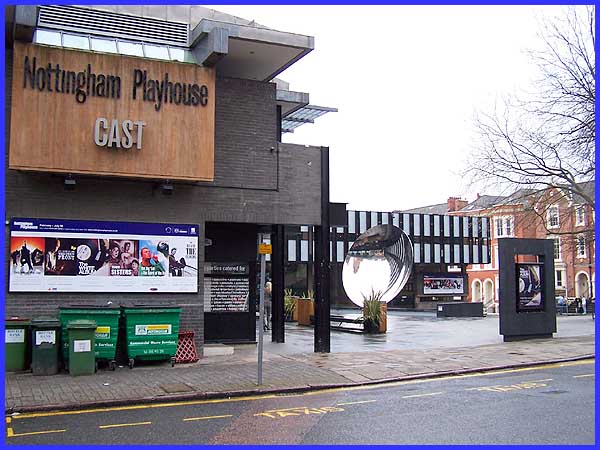
The Nottingham Playhouse began life in 1948 in a converted cinema
in Goldsmith Street and built itself a national reputation for
the excellence of its productions. It was recognised in the 1950s
that better premises were a prime requisite and the City Council
built the present Playhouse designed by the award winning architect
Peter Moro. It opened in 1963 and gained Grade II* listed status
in 1996 in recognition of its outstanding  architectural quality. In 2004 funds raised
from grants and various other sources were used to create a new
bar and restaurant 'Cast' seen above and a new education space.
Outside the Playhouse and also shown above is Anish Kapoor's
sculpture , the 'Sky Mirror'. The Albert Hall (right) standing
next to the Playhouse is a centre for conferences and exhibitions
and also stages orchestral and choral concerts. The Hall is home
to the 'Binns Organ' which has been restored and is now in full
working order. The organ, given to the City of Nottingham by
Sir Jesse Boot, was built in the Albert Hall Methodist Mission
by J. J. Binns in 1909. architectural quality. In 2004 funds raised
from grants and various other sources were used to create a new
bar and restaurant 'Cast' seen above and a new education space.
Outside the Playhouse and also shown above is Anish Kapoor's
sculpture , the 'Sky Mirror'. The Albert Hall (right) standing
next to the Playhouse is a centre for conferences and exhibitions
and also stages orchestral and choral concerts. The Hall is home
to the 'Binns Organ' which has been restored and is now in full
working order. The organ, given to the City of Nottingham by
Sir Jesse Boot, was built in the Albert Hall Methodist Mission
by J. J. Binns in 1909.
|
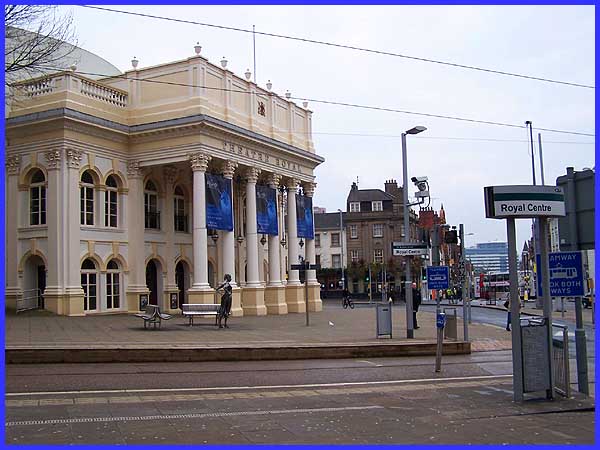
A major road realignment and the construction of the tram system
has created a pleasant open space in front of the Theatre Royal
but the facade with its Corinthian columns still looks very similar
to when it first opened in 1865. In the early days it staged
music hall and variety shows, opera, drama, and by the twenties
and thirties of the last century it was staging musicals and
pantomimes. Its heyday seemed to have passed by the late 1960s
but it was purchased by the City Council in 1969 and restoration
work begun so that when it reopened in 1978 it featured facilities
that have made it one of the best touring venues in the country.
|
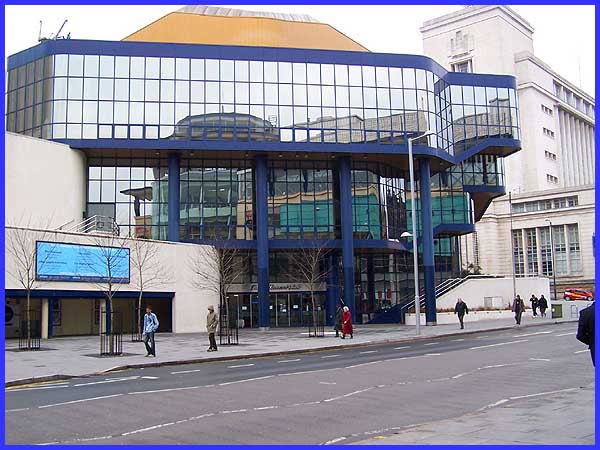
The success of the Theatre Royal's restoration led to the second
phase of the project which saw the Royal Concert Hall being built
between 1980 and 1982 on the site of the old Empire Theatre of
Varieties. The Empire originally stood alongside the Theatre
Royal and opened in 1898 on the site of the Royal's old dressing
rooms. For sixty years until its closure in 1958, the Empire
hosted more risque shows than its  neighbour and such stars as Charlie Chaplin
and Harold Lloyd topped the bill. It was finally demolished in
1969. Now opposite the Royal Concert Hall and seen in the reflection
above and also in the small image right, is one of Nottingham's
newest entertainment centres, the Corner House. Built on the
former site of the local newspaper, the Nottingham Evening Post,
it is promoted as being the city's 'Leading Leisure and Entertainment
Destination' with bars, restaurants, computer gaming, shops,
nightclubs, health, beauty and fitness centres. Not quite 'theatre'
in the same sense as the Royal or the Playhouse but the complex
also includes a multi-screen cinema. neighbour and such stars as Charlie Chaplin
and Harold Lloyd topped the bill. It was finally demolished in
1969. Now opposite the Royal Concert Hall and seen in the reflection
above and also in the small image right, is one of Nottingham's
newest entertainment centres, the Corner House. Built on the
former site of the local newspaper, the Nottingham Evening Post,
it is promoted as being the city's 'Leading Leisure and Entertainment
Destination' with bars, restaurants, computer gaming, shops,
nightclubs, health, beauty and fitness centres. Not quite 'theatre'
in the same sense as the Royal or the Playhouse but the complex
also includes a multi-screen cinema.
|
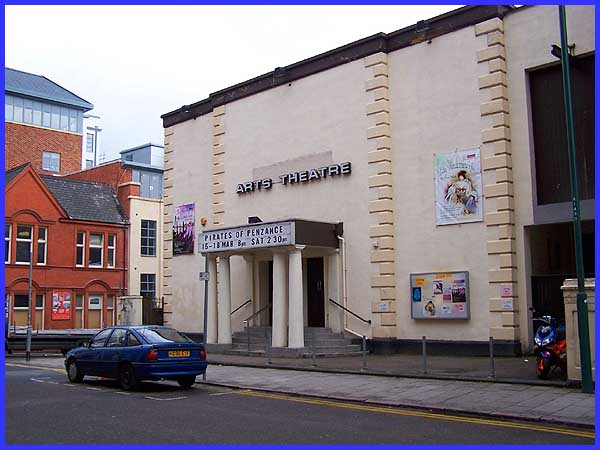
The Co-operative Arts Theatre officially opened its doors in
1948, the same year as the Nottingham Playhouse on Goldsmith
Street, although the actual Theatrical Society traces its roots
back to the Co-operative Choir in the early 1900s. An accompanying
drama group calling itself The People's Theatre was formed in
1944 and gave performances in the Co-operative Hall in Parliament
Street. As the group's popularity grew the department store's
Directors purchased the George Street Baptist Chapel for use
as a cultural centre and since then, it has not only become well
established in the local community but is also used by both amateur
and professional visiting groups to stage plays, operas, musicals,
revues and pantomimes. Last week's production was Gilbert and
Sullivan's 'Pirates Of Penzance'.
|
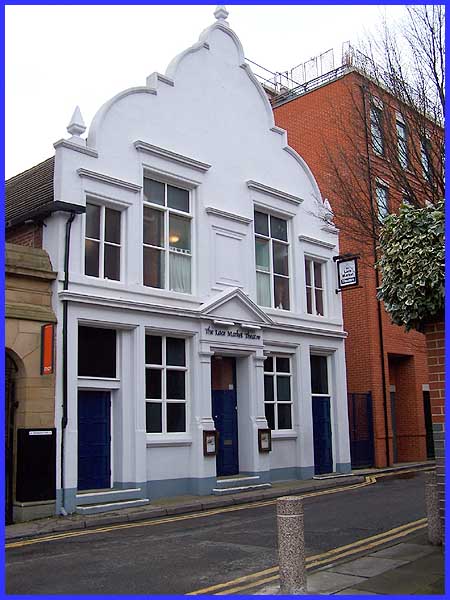
Another amateur group operates in a small theatre tucked away
in a narrow street in the Lace Market area not far from the city
centre. The theatre appropriately called the Lace Market Theatre
is owned and operated by a registered charity and produces a
varied programme of drama, comedy and musicals. There is also
a Youth Section for 11 to 18 year olds running a number of activities
including regular Drama Workshops.
|
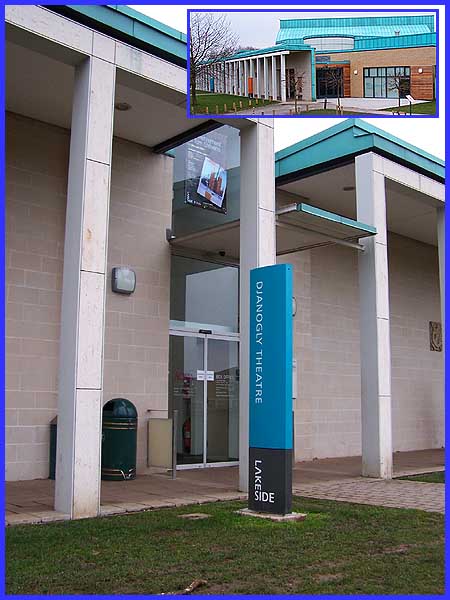
Our final port of call on this whistle stop tour of Nottingham's
theatreland is at Highfields Park. This is the University of
Nottingham's public arts facility, Lakeside. The centre is situated
in the D. H. Lawrence Pavilion (inset) and includes a restaurant,
galleries and the Djanogly Theatre which has seating for 250
people. Year round events include exhibitions, drama, music,
ballet, comedy, contemporary dance, visual art, literary and
family events, cinema and workshop activities for children and
young people. So whatever your taste, there is something to suit
everyone within easy reach of the city centre and as Leo Sayer
sang:'The Show Must Go On'.
Each of the theatres featured on this page has a website and
you can find out more about them and their current productions
by following these links:
Nottingham
Playhouse - The Albert Hall
Theatre
Royal & Royal Concert Hall - The Corner House
The
Arts Theatre - The Lace Market Theatre
Lakeside
& the Djanogly Theatre
|

